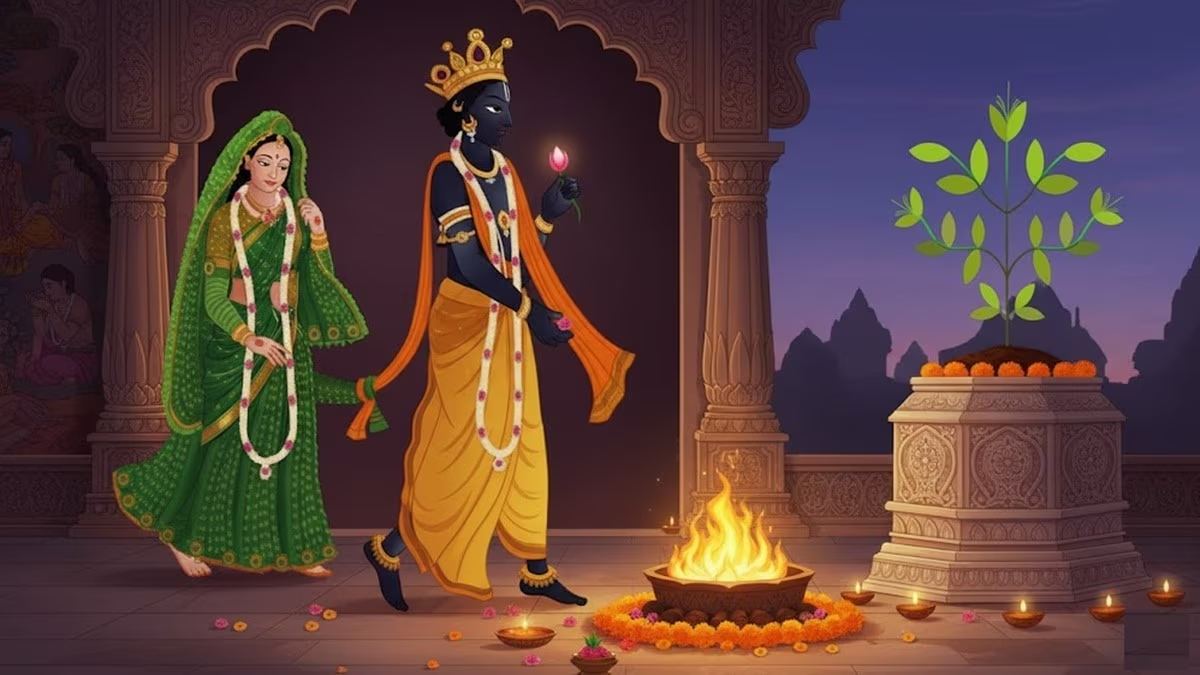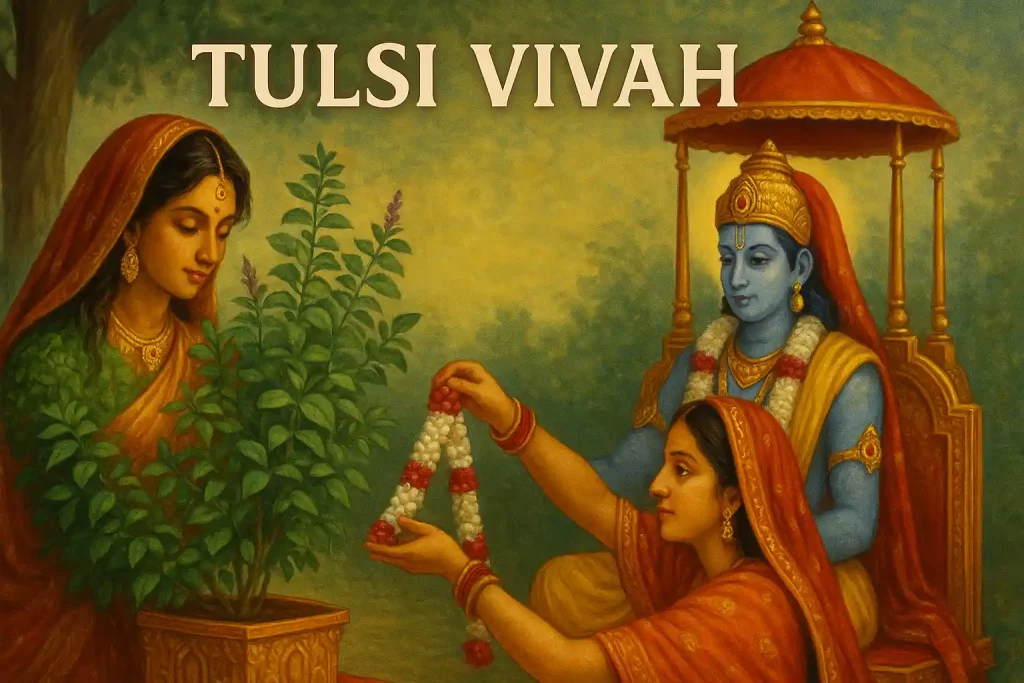- General
- Updated on October 30, 2025
The Spiritual Significance of Tulsi Vivah: Why It’s More Than Just a Ritual

Introduction
In the heart of every Indian home, nestled near the courtyard or on the balcony, stands a sacred plant — Tulsi, or Holy Basil. Beyond being a medicinal herb, Tulsi holds deep spiritual and cultural importance in Hinduism. Among the many rituals associated with her, Tulsi Vivah stands out as one of the most sacred and symbolic.
Celebrated annually on the Ekadashi or Dwadashi Tithi of the Shukla Paksha in the month of Kartik (October–November), Tulsi Vivah marks the divine union of Tulsi (Vrinda) and Lord Vishnu (in the form of Shaligram). This festival not only celebrates divine love but also signifies purity, devotion, and the harmonious connection between nature and divinity.
But Tulsi Vivah is much more than a traditional ceremony — it’s a profound spiritual metaphor, one that reminds us of the power of faith, the sanctity of nature, and the eternal rhythm of creation.
The Divine Story Behind Tulsi Vivah

The origin of Tulsi Vivah is rooted in an ancient Hindu legend — a tale of love, devotion, betrayal, and transformation.
According to sacred texts, Vrinda was a pious woman, deeply devoted to her husband Jalandhar, a mighty demon king born from Lord Shiva’s anger. Jalandhar’s strength was extraordinary — as long as his wife remained pure and faithful, no god could defeat him.
In his arrogance, Jalandhar began challenging the gods and disrupting cosmic harmony. To restore balance, Lord Vishnu devised a plan. He took the form of Jalandhar and deceived Vrinda, breaking her penance and her chastity. When Vrinda realized the deception, she was heartbroken. In her anguish, she cursed Vishnu to become stone — transforming him into Shaligram, a sacred black stone worshipped as Lord Vishnu’s manifestation.
Overcome with remorse, Vishnu blessed Vrinda, declaring that she would be reborn as the Tulsi plant and that he would marry her in this new form to honor her devotion. Their union would be celebrated eternally as Tulsi Vivah.
Thus, the ritual symbolizes divine forgiveness, eternal love, and the merging of devotion and divinity — a reminder that every end in life leads to a spiritual beginning.
The Symbolism of the Divine Union
The marriage of Tulsi and Vishnu is not just a mythological story — it’s a spiritual allegory. Tulsi represents the devoted human soul, pure and unwavering in its love and faith. Vishnu, on the other hand, represents the Supreme Divine, who ultimately unites with the soul through devotion and surrender.
Their union is symbolic of the merging of the earthly and the spiritual realms — a reminder that when devotion is pure, it draws the Divine closer. This is why Tulsi Vivah is celebrated with such reverence — it’s a reminder that faith, love, and surrender can bridge the distance between mortal life and the divine.
The Spiritual Essence of Tulsi
Tulsi is far more than a plant in Hindu tradition — she is “Vrinda Devi”, an embodiment of purity, compassion, and unwavering faith. Every part of the Tulsi plant is considered sacred, from her leaves to her roots.
Here’s what Tulsi symbolizes spiritually:
- Purity and Protection: Tulsi is believed to cleanse not only the physical environment but also the mind and soul of negativity. Her presence in the home is said to attract positivity and ward off evil.
- Connection to the Divine: Worshipping Tulsi connects devotees to Lord Vishnu and encourages spiritual discipline, humility, and devotion.
- Balance of Nature: Tulsi represents the sacred balance between humans and nature. She reminds us that divinity resides in every leaf, stone, and breath of air.
- Transformation and Renewal: The story of Vrinda’s transformation into Tulsi teaches forgiveness, resilience, and spiritual rebirth — that divine love transcends suffering and leads to growth.
No wonder she’s called “Tulsi – The Queen of Herbs.” Her significance stretches beyond rituals — she’s a symbol of how faith, purity, and nature coexist harmoniously in Hindu life.
The Rituals and Celebration of Tulsi Vivah
People across India celebrate Tulsi Vivah with immense joy and devotion, especially in Maharashtra, Gujarat, Uttar Pradesh, and Bihar. Families often perform the ritual at home, while temples also host grand ceremonies.
Devotees dress the Tulsi plant, usually kept in a decorated Tulsi Vrindavan (a small altar), as a bride — adorning her with a red or green saree, ornaments, turmeric, and vermilion (sindoor). They place a small idol or image of Shaligram beside her, representing Lord Vishnu as the groom.
The ceremony follows traditional Hindu wedding customs — including chanting of mantras, applying turmeric and kumkum, performing kanyadaan, tying the sacred thread (mangal sutra), and offering sweets and flowers.
Family members and neighbors gather to witness the union, sing devotional songs, and share prasad. It’s a heartwarming sight — a celebration where the divine and domestic blend seamlessly.
Tulsi Vivah: The Beginning of the Wedding Season
Tulsi Vivah is also culturally significant because it marks the end of Chaturmas — a four-month period considered inauspicious for marriages and major ceremonies. With the conclusion of Tulsi Vivah, the Hindu wedding season officially begins.
This transition carries deep meaning. It signifies that after months of restraint and introspection, it’s time for renewal, new beginnings, and joyous unions. Just as Tulsi and Vishnu unite in divine matrimony, countless human couples begin their journey of love and partnership under their blessings.
In many families, newlyweds participate in Tulsi Vivah as a symbolic gesture to strengthen their bond and invite divine grace into their marriage.
Beyond the Ritual: Lessons in Faith and Ecology
At a time when rituals often become routine, Tulsi Vivah offers a chance to reconnect with their deeper essence. It’s not just about lighting lamps and singing hymns — it’s about understanding what these acts symbolize.
Spiritually, Tulsi Vivah teaches us:
- Devotion transcends form: Vrinda’s love for Vishnu remained pure, even after her transformation. It reminds us that love and faith are eternal energies.
- Forgiveness leads to liberation: Vrinda’s story teaches that letting go of pain and resentment opens the door to spiritual awakening.
- Nature is divine: Tulsi’s transformation from a human devotee into a sacred plant illustrates the inseparable bond between nature and divinity.
On a more contemporary level, the ritual also emphasizes environmental consciousness. Worshipping Tulsi is a way of acknowledging nature’s role in sustaining life. By nurturing her plant, devotees participate in ecological preservation, transforming faith into sustainable action.
In many ways, Tulsi Vivah is one of the earliest celebrations of eco-spirituality — the understanding that caring for nature is, in itself, an act of devotion.
Tulsi Vivah and Emotional Well-Being
Apart from its religious and ecological significance, Tulsi Vivah carries deep emotional resonance. The act of celebrating this divine marriage brings families together — across generations — in an atmosphere of warmth, devotion, and joy.
For elders, it’s a moment to pass down stories and traditions. For children, it’s a living lesson in faith, compassion, and respect for nature. The preparation — from decorating the Tulsi Vrindavan to singing devotional songs — creates a sense of shared purpose and spiritual unity.
On a deeper psychological level, rituals like Tulsi Vivah promote mindfulness. They allow devotees to pause, reflect, and connect with the divine — fostering gratitude, peace, and emotional balance amid daily chaos.
The Deeper Spiritual Meaning
When we look beyond the myth and ritual, Tulsi Vivah is ultimately a story of divine love and surrender. Tulsi (Vrinda) represents the individual soul’s journey — filled with trials, love, loss, and transformation. Vishnu represents the divine consciousness — the eternal, unchanging truth.
Their union signifies the ultimate spiritual goal: the merging of the soul with the Divine.
In this sense, Tulsi Vivah is a spiritual metaphor — teaching that every act of love, sacrifice, and faith brings us one step closer to divine realization.
The ceremony reminds us that divinity is not distant; it blooms quietly in our homes, in our hearts, and even in the humble green leaves of a Tulsi plant.
Why Tulsi Vivah Still Matters Today
In our modern, fast-paced lives, where spirituality often takes a backseat, Tulsi Vivah stands as a reminder of simplicity, gratitude, and connection.
It teaches us that spirituality doesn’t always need grand temples or elaborate rituals — sometimes, it lives in the small act of watering a plant, lighting a lamp, or offering a prayer at dawn.
Tulsi Vivah also carries a timeless ecological message: that nature and humanity are intertwined, and honoring this connection is key to a peaceful existence. By celebrating Tulsi Vivah, we honor not just a divine marriage, but the sacredness of all life.
Also Read: Vaikuthi Chaudas 2025: Date, Rituals, and the Meaning Behind the Celebration
Conclusion
Tulsi Vivah is more than a festival — it’s a celebration of divine love, purity, and the eternal dance between creation and devotion. It bridges mythology with mindfulness, ritual with reflection, and nature with spirituality.
“True devotion transforms. True love endures. And in every act of faith, the Divine resides.”
Whether you perform the ritual at home or simply offer your prayers to the sacred plant, the essence remains the same — to honor love, life, and the everlasting bond between humanity and the divine.
Join the discussion
Related Articles
No results available
ResetTrending Articles


- General
- Updated on November 19, 2025


- General
- Updated on November 19, 2025


- General
- Updated on November 14, 2025


- Tech
- Updated on November 12, 2025


- General
- Updated on November 8, 2025


- General
- Updated on November 6, 2025


- Sports
- Updated on November 5, 2025


- General
- Updated on November 4, 2025


- General
- Updated on November 1, 2025

- General
- Updated on October 30, 2025
No results available
Reset


